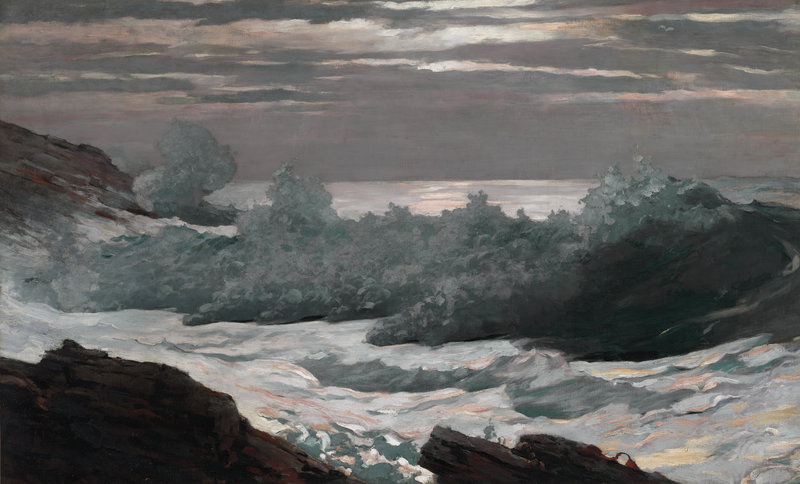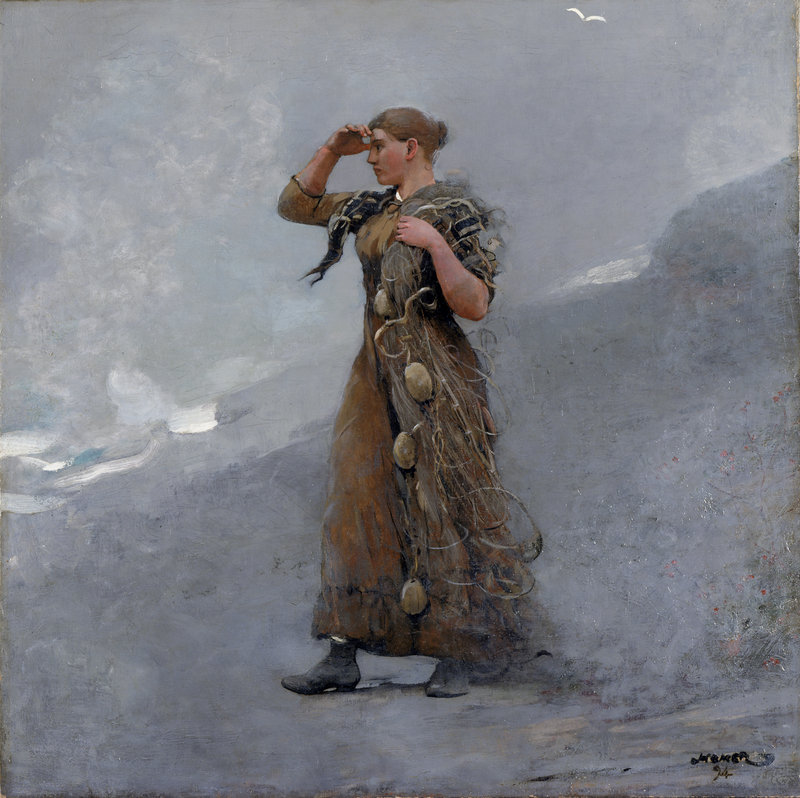“Weatherbeaten: Winslow Homer and Maine” is a show no one should miss. It is an ambitious and handsome presentation of Homer as the mature and indomitable Maine painter of world renown.
While the Portland Museum of Art says the point of the exhibition of 38 works is to commemorate the newly restored Homer studio on Prout’s Neck (tours begin Tuesday), “Weatherbeaten” showcases Homer’s greatest accomplishment: his seascapes.
Homer’s masterpiece “Fox Hunt” is reason enough to visit. It was snatched up by the Pennsylvania Academy of Fine Arts in 1893 when it was practically still wet. It has rarely traveled since, and this is its first trip to Maine.
The moonlit seascape features a pair of hungry crows leading an attack on a fox slowed by deep snow. No reproduction could possibly convey the luscious complexity of the fox’s coat or show how the red berry-laden bush branches replaced their quickly-painted-over predecessors.
The full-figured “The Fisher Girl” (1894) is a gorgeous example of Homer’s figurative work. The subject is a heroically solid but beautiful young woman looking out to sea. The entire landscape has been consumed by a rich lavender gray mist, but only as an afterthought. The painted-over landscape is easily visible just to her right.
Painting out the landscape begs significant questions about the roots of Homer’s art. Did Homer’s two years on the England coast connect him to artists such as the great marine watercolorist Richard Parkes Bonington (1802-28)? Or did Homer espouse the school championed by then-celebrated French painter Jules Bastien-LePage (1848-84), who placed Realist-style figures in Impressionist-style landscapes?
“A Light on the Sea” (1897) quietly takes on John Singer Sargent’s great “El Jaleo.” Instead of Sargent’s harshly frenetic flamenco, Homer’s handsome fisher woman dances to the natural pulse of the moonlit sea. Her oddly small and strangely twisted foot pivots her curving body into a rhythmic step by means of red ellipses pulsing across the canvas from her quietly exposed ankle.
Drawn to nature’s roiling power and the liminal edges of human consciousness, Homer is at his best with his seascapes. His stubbornly sentient brush refuses to subscribe to any simple stylistic recipe.
Homer himself said “Early Morning After a Storm at Sea” (1902) was one of his greatest paintings, yet it does odd things. The central foaming breaker doesn’t catch the same light as the thickly impastoed white of the foamy foreground or the moonlight-reflecting ocean behind. The breaker is oddly muted as though Homer worked around it to finish the painting with frosting-thick white in the cloud-streaked sky, ocean horizon and lapping-foam foreground. The foaming surf features punctuating streamers of pink and yellow — a jaunty phrase in the otherwise cool and crystalline solitude of an early winter morning.
Homer is a unique and even strange colorist. While his marines are unsurprisingly dominated by viridian (a deep blue-green pigment), his warm colors often stand out from his default coolness.
His atmospheres feature deliciously moist lavender. His complementary grays are subtly rich. His impastos are a thick, cold white, although he sometimes highlights with a creamy Venetian yellow or the whites of gray granite to make them stand out from their warm-brown rocky counterparts dominated by Mars red.
Homer’s refusal to adopt, for example, blue shadows in snow reveals the kind of stubborn individualism that Americans now associate with artists. He rarely takes the easy way out, even though his active and varied brushwork makes it clear he could do pretty much anything with a brush: The staccato flurry of white strokes in “Watching the Breakers — A High Sea” (1896) is a rare example of unnecessarily showy brushwork.
We now honor Homer’s economic brushwork, but he was admonished for it by contemporary critics who wanted more focus, finish and fuss. While he was capable of seductive brushwork (think Sargent), Homer was allergic to affect, and insisted on visually articulate intelligence.
The key spots in “Weatherbeaten” are perfectly occupied by show stoppers: the dreamily intense “Artist’s Studio in an Afternoon Fog” (1894), the masterful title piece (1894), my personal favorite “On a Lee Shore” (1900) and “Fox Hunt.”
Also well-placed is “West Wind” (1891). Homer felt strongly about seeing paintings from afar; from a distance, this piece looks like a three-rock cairn by a small bush. But on closer inspection, it becomes a woman in front of a tree — so from farther, it looks closer. It’s brilliant.
One frustrating bit of weirdness, however, involves the iconic “Eight Bells” (1886). In the first room of the exhibition, this painting of two seamen working a sextant (you can feel N.C. Wyeth’s love for Homer in this great work) is accompanied by Homer’s etching of the same scene. But the same print is included later in the show.
It’s disappointing, because it wrongly hints of a limited body of work. Homer was a great and prolific printmaker, and the PMA owns more than 400 of his graphic works.
So while the label copy and (fantastic) catalog talk up Homer’s draftsmanship and printmaking proclivity — and there are enough watercolors to illustrate his reigning greatness in that medium (“Blown Away” stands up to anything in the show) — “Weatherbeaten” doesn’t really give us the fully rounded artist or the populist printmaker. This Homer is the reclusive painter of Maine.
While the opening of Homer’s studio is newsworthy, it will be around for a long time to come. “Weatherbeaten,” on the other hand, will only be up through Dec. 30, and it’s a show that you should see again and again.
Freelance writer Daniel Kany is an art historian who lives in Cumberland. He can be contacted at:
dankany@gmail.com
Send questions/comments to the editors.




Success. Please wait for the page to reload. If the page does not reload within 5 seconds, please refresh the page.
Enter your email and password to access comments.
Hi, to comment on stories you must . This profile is in addition to your subscription and website login.
Already have a commenting profile? .
Invalid username/password.
Please check your email to confirm and complete your registration.
Only subscribers are eligible to post comments. Please subscribe or login first for digital access. Here’s why.
Use the form below to reset your password. When you've submitted your account email, we will send an email with a reset code.